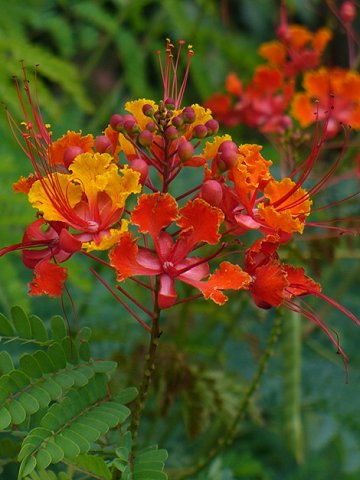
|
|
Caesalpinia
( Caesalpinia pulcherrima)
|
Caesalpinia - Caesalpinia pulcherrima
Caesalpinia is a genus of flowering plants in the legume family, Fabaceae. Membership within the genus is controversial, with different publications including anywhere from 70 to 165 species, depending largely on the inclusion or exclusion of species alternately listed under genera such as Hoffmannseggia. It contains tropical or subtropical woody plants. The generic name honors the botanist, physician and philosopher Andrea Cesalpino (1519-1603).
Caesalpinia pulcherrima is a species of flowering plant, that is native to the tropics and subtropics of the Americas. Its exact origin is unknown due to widespread cultivation. Common names for this species include Poinciana, Peacock Flower, Red Bird of Paradise, Mexican Bird of Paradise, Dwarf Poinciana, Pride of Barbados, and flamboyan-de-jardin.
It is a shrub growing to 3 m tall. The leaves are bipinnate, 20-40 cm long, bearing 3-10 pairs of pinnae, each with 6-10 pairs of leaflets 15-25 mm long and 10-15 mm broad. The stem and branches are armed with spines.
The flowers are borne at the end of the prickly branches, in racemes up to 20 cm long, each flower with five yellow, orange or red petals.
The fruits are legumes. The fruit is a pod 6-12 cm long.
When ripe they split open and release the brown bean.
Closely related is the Yellow bird of paradise (Caesalpinnia gilliesii) which has yellow flowers with long red stamens.
The young seeds of this plant are edible and reportedly taste like peas when the inedible seed coat is removed.
However the seeds of its close relative lant, Caesalpinia gillesii (Yellow bird of paradise)
aradise are poisonous and cause severe irritation of the digestive tract!
C. pulcherrima is the most widely cultivated species in the genus Caesalpinia. It is a striking ornamental plant, widely grown in domestic and public gardens and has a beautiful inflorescence in yellow, red and orange. Its small size and the fact that it tolerates pruning well allows it to be planted in groups to form a hedgerow; it can be also used to attract hummingbirds.
Red Bird of Paradise is the national flower of the Caribbean island of Barbados, and is depicted on the Queen's personal Barbadian flag.
Medicine men in the Amazon Rainforest have long known some of the medicinal uses for Caesalpinia pulcherrima, which is known as ayoowiri. The juice from the leaves is said to cure fever, the juice from the flower is said to cure sores, and the seeds are said to cure bad cough, breathing difficulty, and chest pain. Four grams from the root is also said to induce abortion in the first trimester of pregnancy.
The leaves are purgative and used against kidney stones, malarial fever and bronchitis.
Source:
http://en.wikipedia.org/wiki/Caesalpinia
http://en.wikipedia.org/wiki/Caesalpinia_pulcherrima
http://www.gardeninginsights.com/html/articles/edibleplants.htm
http://www.tropilab.com/caesal-pul.html
